Instead of sending humans on a long and probably very painful mission to colonize Mars, how about sending human corpses in outer space to aggregate and form a new planet?
Julijonas Urbonas‘ new project proposes to do just that. A Planet of People would be created by sending human bodies to the L2 point of the Earth-Sun system, one of the Lagrangian points in space where the gravity is absent. There, the frozen bodies would float around until their weak gravities make them assemble into a huge celestial body: “in this way, a new ‘human’ planet is extra-terraformed. A cosmic fossil of humanity. A monument to humans of humans.”
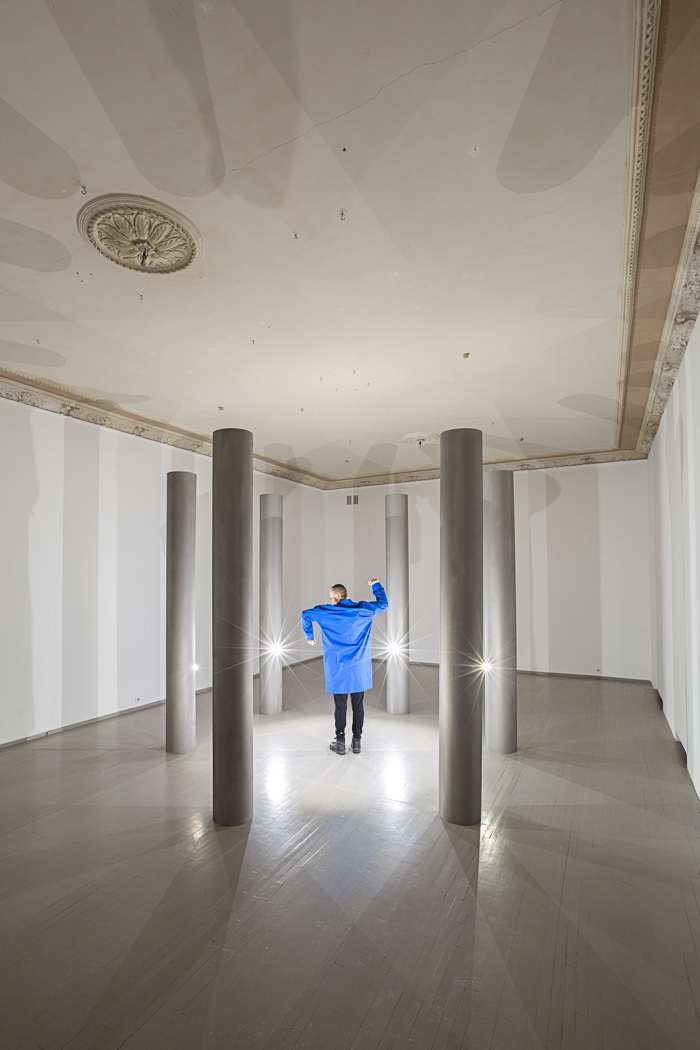
Julijonas Urbonas, A Planet of People, 2017 – 2019. 3D human scanner installation view, Vartai Gallery, Vilnius
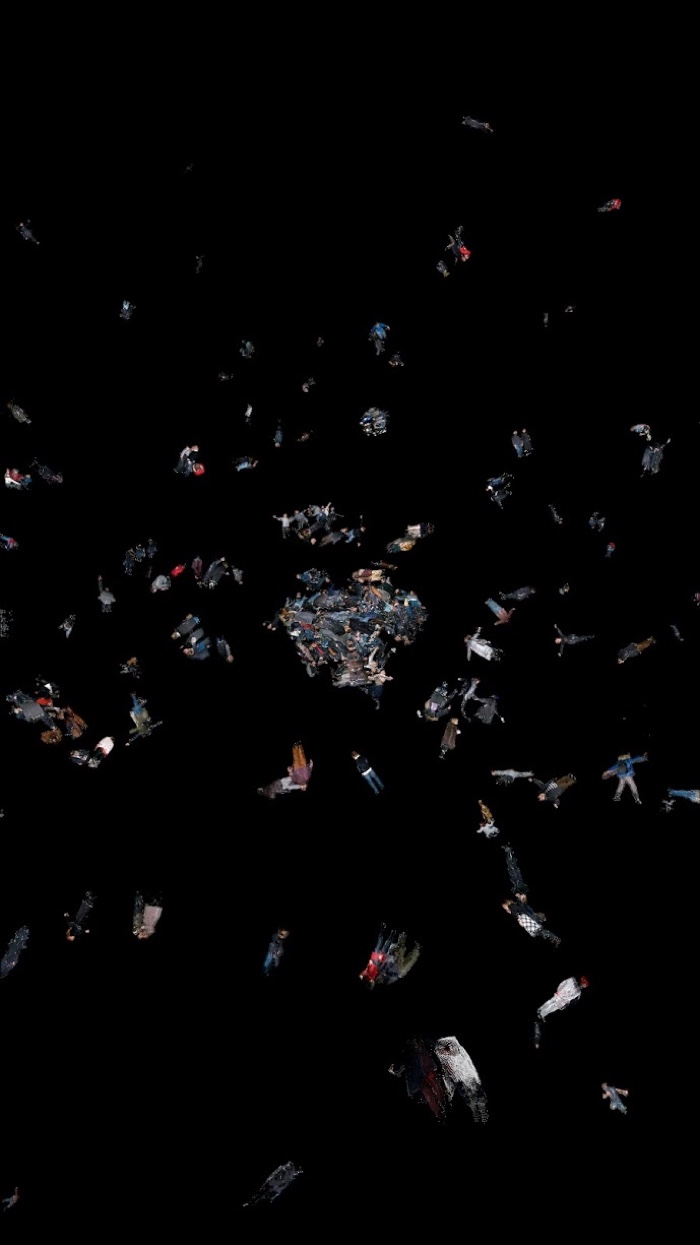
Julijonas Urbonas, A Planet of People, 2017 – 2019. Screenshot showing the overview of the recently scanned bodies, Vartai Gallery, Vilnius
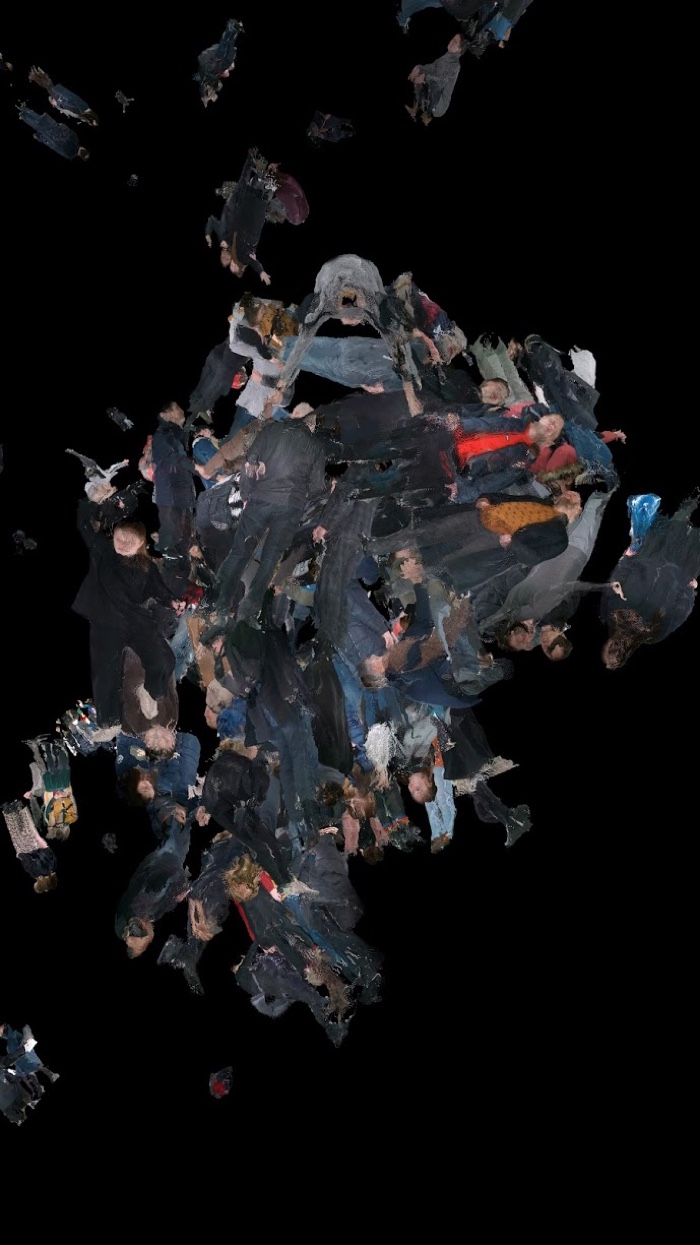
Julijonas Urbonas, A Planet of People, 2017 – 2019. Screenshot showing the overview of the recently scanned bodies, Vartai Gallery, Vilnius
The project speculates upon the aesthetic, ethical and scientific aspects of such a formation into space.
What spatial structures would it be possible to choreograph? How would a landscape of biomass look like on such a planet? What biochemical processes would it undergo, and would it form its own ecosystem eventually? And what would be the ethical, cultural and political implications, both here on Earth and out there?
A Planet of People might be speculative but it is deeply anchored in science. It draws on disciplines such as biomechanics, space law, space medicine, astrophysics or astrogeology to reflect upon the establishment of exo-disciplinary arts (architecture, choreography and other forms of arts influenced by the exposure to the extreme conditions encountered in outer space.) In addition, the work invites us to question our traditional definitions of human species and life in general.
The results of Urbonas’ artistic research into the scientific feasibility study of this artificial planet were exhibited last month at the Galerija Vartai in Vilnius. Visitors of the exhibition could get their body scanned in 3D and transposed into a 3D astrophysics simulation. They would then be able to watch their body fly and join the ones of the previous visitors, slowly adding to the planetary mass.
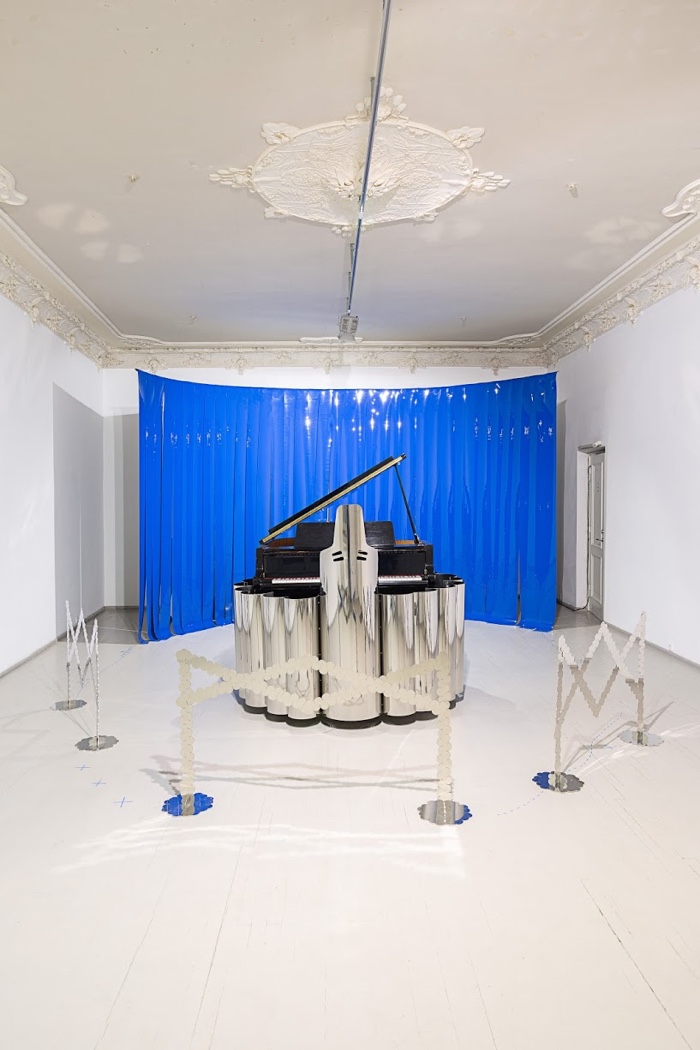
Julijonas Urbonas, Hypergravitational Piano, 2017 – 2019. Installation view, Vartai Gallery, Vilnius
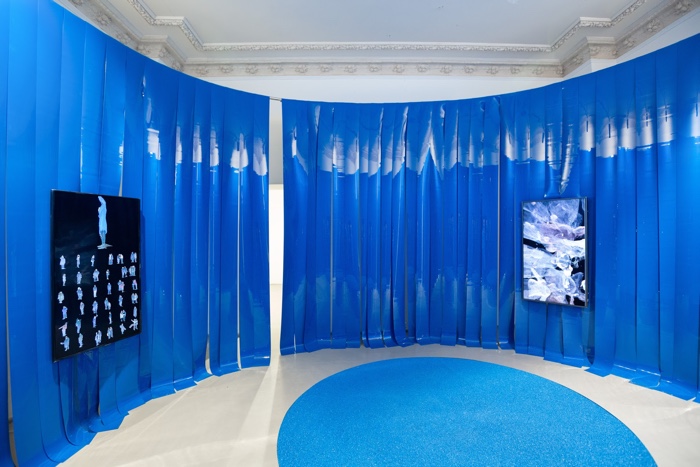
Julijonas Urbonas, A Planet of People, 2017 – 2019. Astrophysics simulation room view, Vartai Gallery, Vilnius
I’m still wondering how we would understand this planet made of human corpses: Would we use it as glorified resting place for the ultra rich? Would we regard it as a monument that celebrates humanity’s sense of adventure? Would it become the ultimate relic of our presence in the universe after we’ve made the Earth so toxic our whole species has disappeared? Or will it just be yet another piece of space trash?
I asked artist, designer, researcher, engineer and former Director of a Soviet amusement park Julijonas Urbonas to tell us more about his intriguing project:
Hi Julijonas! First, i’d like to ask you about Cosmic Lithuanias, a project in which you reflect on the cosmic identity of a Lithuanian. Unfortunately, I’ve never been in Lithuania and i don’t know anything about the cosmic identity of the country (nor do I know anything about the cosmic identity of my own country for that matter). What makes this cosmic identity worth investigating?
The cosmic history of Lithuania spans over four centuries and it involves things such as: Kazimieras Simonavičius’ idea for multi-stage rockets in 1650; the establishment of one of the oldest astronomical observatories in Europe in 1753; the first successful attempt to grow plants “from seed to seed” in space; establishment of the Lithuanian Aerospace Association in 2009; and, most recently, the launch of several Lithuanian nanosatellites. The latter transmitted audio recordings in Lithuanian language back to earth. The messages included “Lithuania loves freedom”, and the voice recording of Lithuania’s President Dalia Grybauskaitė saying “Greetings to all Lithuanians around the world!”
Actually, it is these Lithuanian satellites that provoked my concern about the national space culture, which is monopolized by technologists and businessmen. What’s the value of such celestial messages addressed to a super tiny, narrow and rather techy community – radio hams? I wonder how many of them spoke Lithuanian and even if they did, what have they learned from hearing such a truism? Ultimately, how does this achievement differ from Sputnik 1, the world’s very first artificial satellite that broadcasted nothing but beeps?

“Fiton-3” – a micro-greenhouse developed by Lithuanian scientists. It was sent to Salyut 7 space station in 1982. During their 40-day lifecycle, Arabidopsis plants became the very first plants to flower and produce seeds in the zero gravity of space
Despite the prevalence of nerdy ideas, our cultural discourses have not produced any critical responses to this. It is as though our culture terminated at the Kármán line, an arbitrary designation that lies at an altitude of 100 km above Earth’s sea level and commonly represents the boundary between the earth’s atmosphere and outer space. I set out to do something about it and push Lithuanian culture over that line. There were a dozen of ideas that got materialised in the forms of an opera, an extra-terrestrial vodka (it’s under development in collaboration with an astrobotanist Danguolė Švegždienė), a funding application for a Lithuanian Kosmica festival, also lectures, workshops and texts about cosmic imagination and exo-disciplinary arts. One of the ideas has been extremely persistent, constantly recurring in my sketches, daydreams and discussions with scientists. I call it A Planet of People – an artificial planet made entirely of human bodies. I thought it was a very promising idea to spark the discussion about our own cosmic programme. What could be more straightforward than reducing the nation to a collection of the bodies of its citizens that are put into outer space? The nation in space is a cosmic nation. Its provocative tone, simplicity and, most importantly, its uniqueness compared to other space programmes, made it viral. While still at the very early stage of conceptualisation, the idea was selected as one of the most important Lithuanian visions in the book Imagining Lithuania: 100 years, 100 visions, 1918–2018.
The work combines “astroanthropology, speculative engineering, biomechanics, space law, space medicine, astrophysics, astrogeology and space arts.” You worked with astrophysicist Vidas Dobrovolskas for this project and you also were an artist in residency at CERN, so I suspect that the project has got some serious scientific backing. I’m intrigued by the “speculative engineering” side of the work. How much speculation is necessary to engineer this monument to humanity made up of human corpses?
The engineering in this project is speculative in several ways. Firstly, there is little to no engineering knowledge and methods to deal with such an idea. Terraforming, or planetary engineering in general, is still at the stage of sci-fi. Also, no mammal bodies, let alone human bodies, have ever been used as a material for architectural structures with some vaguely related exceptions such as choreographic formation practices (skydiving, human towers, etc.), military biomechanics research, the deviations of serial killers, such as Ed Gein’s designs of human flesh. Secondly, the idea is quite unrealistic logistically. In order to meet the definition of a planet, an unimaginably large number of bodies would be required. If we started sending ourselves out into space today, with the current worldwide birth rate we’d need around one trillion years to form a planet massive enough to be rounded by its own gravity. Thirdly, the idea has unacceptable cultural implications. Hence, we have here a speculative social engineering assignment. And, ultimately, the project might be seen as a bio sci-fi, for which a specific quasi-fictitious engineering should be used to make things work not in reality but in the public imagination. Thus, it is more akin to what Disney called ‘imagineering’.
In my practice, I usually come up with ideas for projects by imagining a certain number of human bodies under unprecedented gravitational circumstances. A few examples: a falling trajectory that pleases and kills, a spin that enhances orgasm, a rocking motion that directs gravitational dreams, etc. In A Planet of People I imagine a large group of people in weightlessness, and soon realise that it is impossible to remove gravity completely. Not only because we are gravitational beings (gravity has been an extremely crucial factor in our evolution), but just because we are objects with mass, hence, according to physics, also with gravity. After their suspension in space for a substantial amount of time, the weak gravitational forces emitted from the bodies would pull them toward each other until they are assembled into a cluster. This ego-centric gravity becomes the driving force of the project.
This is exactly what would happen if we found ourselves in certain locations in outer space. One of such locations may be the Lagrange points that are located between two celestial bodies orbiting around one another (for example, the Sun and the Moon, or the Sun and Earth), in which the gravitational pull from both objects compensate for one another, such that a third body, for example, a space probe, can stay fixed in that point. Imagine a million, a billion or even a number with nineteen zeros (which is the minimum number of bodies required for the formation of a new planet) of frozen human bodies floating around one of the Lagrange points and forming a new celestial body.
Here we’re entering the domain of speculative science and engineering. What spatial structures could we choreograph? How would a landscape look like on such a planet? How would it be affected by space radiation and biochemical changes? What kind of geology or even ecosystem would it eventually produce?
I am currently working on these questions with various scientists working in astrophysics, astrogeology, astrobiology, biomechanics, forensics, etc. Their responses will be featured in a publication that I am currently curating.
So far, the project has been mostly based on astrophysics. One of the major elements of the project is an interactive installation that features a 3D human body scanner. The visitors are scanned and rendered in a 3D astrophysical simulation. The system assigns an individual gravitational field to each body scan and speeds up the interactions between all of them so that their ‘extra-terrestrial dance’ would be visible instantly. This is where the project involves some real engineering, yet its purpose is rather the imaginary workings of the space programme, in which they are both its protagonists and its very content. The interactive installation forces the public to confuse a human being for a planet, thus producing an empathic link with humans freed up from the earthly context.
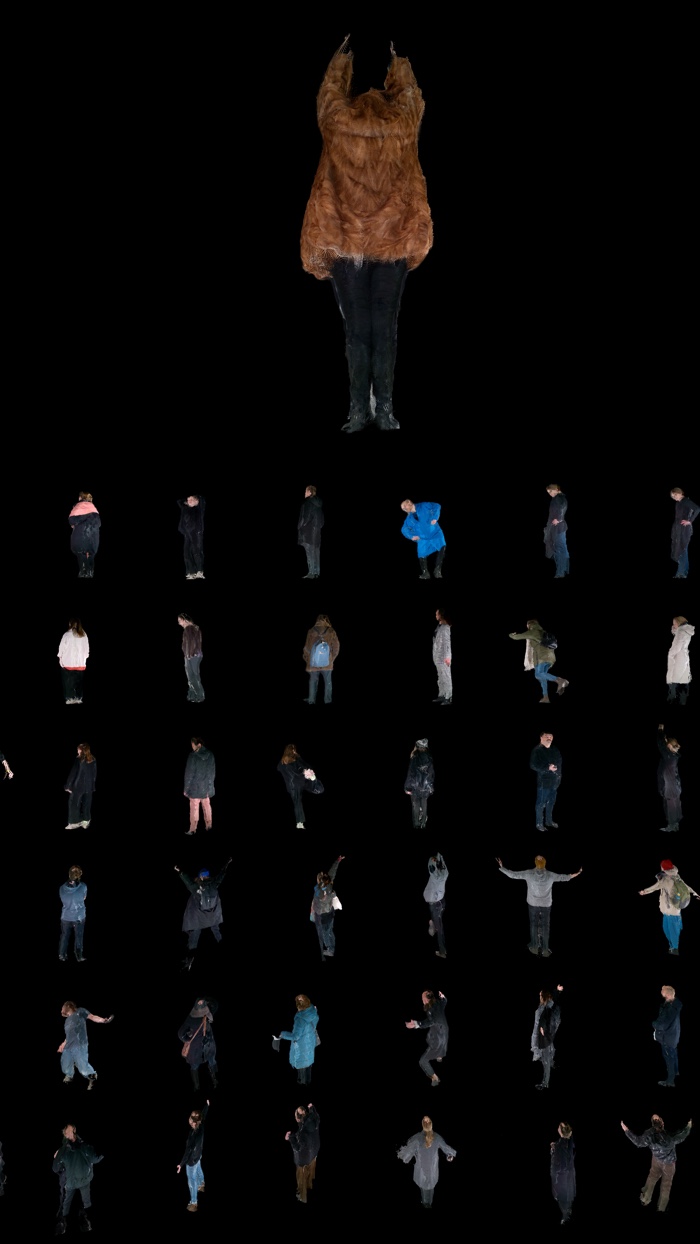
Julijonas Urbonas, A Planet of People, 2017 – 2019. Screenshot showing the overview of the recently scanned bodies, Vartai Gallery, Vilnius
In the scanner, everybody may become a planetary engineer by considering their posture and its influence on the formation of the inter-corporeal structure. This is meant to provoke our choreographic imagination (aka proprioception, or kinaesthetic/motoric imagination). However, after the first exhibition of the project in Life at the Edges in Science Gallery I realised that very few people were aware of such a type of imagination, and the visitors were mostly reluctant in terms of free bodily engagement. The culprit might be our contemporary preoccupation with visualism. The term ‘imagination’ already speaks for itself. In fact, imagination is not only the domain of eyes, but also that of all the other senses. This realisation made me take a deeper look into the creative means that would facilitate choreo-imagination. I was considering various rope and harness suspensions systems used for special effects in cinema, a specially instructed choreographer-cum-installation-operator, etc. The majority of these ideas appeared too cumbersome and didactic, so I settled down on scenography and animation. In the second version of the installation at the gallery “Vartai” in Vilnius I designed an immersive atmosphere by hiding the cables, devices and machinery – everything that would reveal the working principles of the installation and remind the participants of the present times. In order to facilitate the choreographic imagination even more, in the next stage of the project we are going to use automatic skeleton recognition system that would rig and animate the virtual bodies. The latter will constantly change their postures through randomised choreography and changing contact points. The body owners will be able to dance extra-terrestrially without actually moving. Have you ever tried huddling up with other bodies in armpit-heel-chin-chin-forefinger configuration?
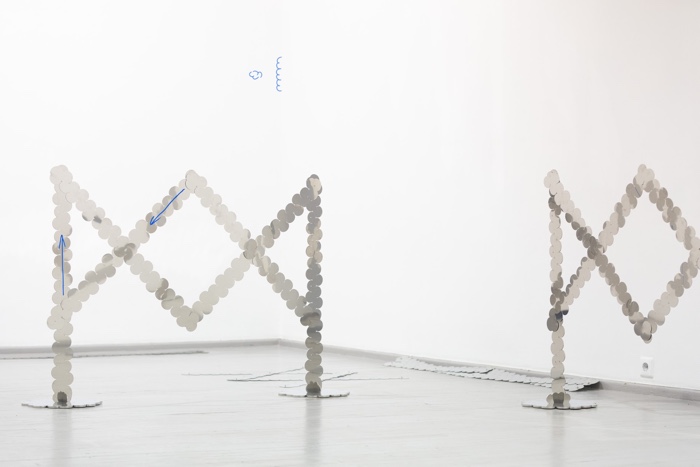
Julijonas Urbonas, Hypergravitational Piano,, 2017 – 2019. Installation view, Vartai Gallery, Vilnius
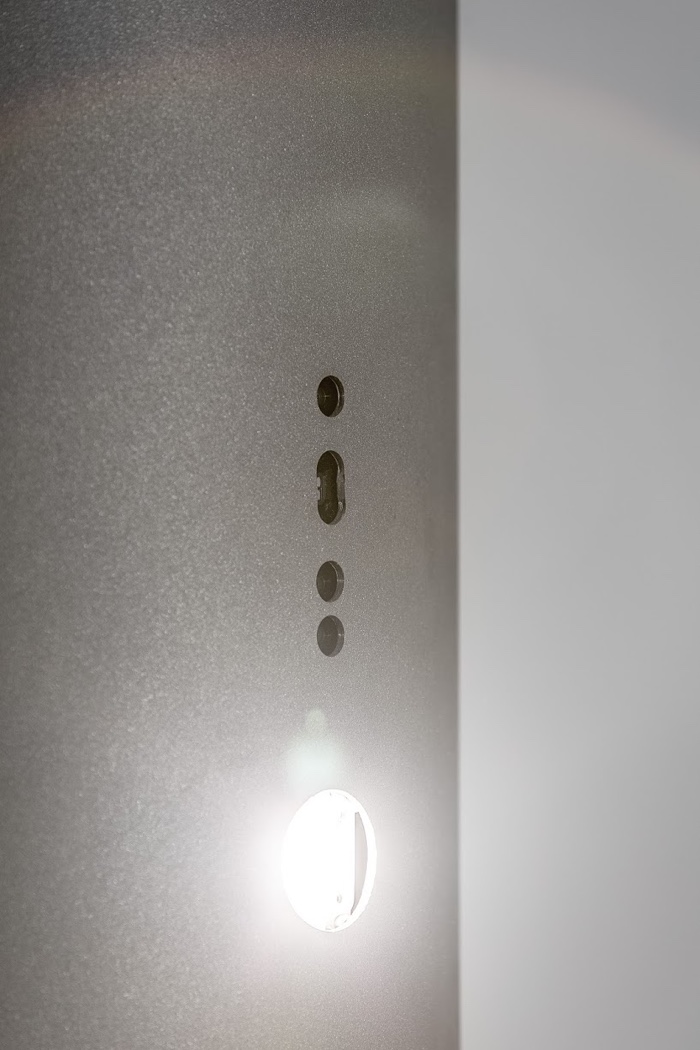
Julijonas Urbonas, A Planet of People, 2017 – 2019. 3D human scanner detail view, Vartai Gallery, Vilnius
There’s something quite disturbing and outrageous about A Planet of People. I suspect it is because it’s difficult not to think about whether or not people would like end up being part of this monument. Or whether they would like their loved ones to end up there. How do people react to the project? Do they feel, like I did for example, that a person would not be completely dead if its body were to remain intact and float out there?
People indeed do feel provoked, but I’ve met only a few people who’ve been genuinely disturbed by the idea. It looks like you’re one of these very few. Actually, it is not unexpected. Perhaps, the reason for the acceptance of this idea lies in our current obsession with apocalyptical ideas and eschatological thinking. In times where extinction is a matter not of speculative fiction, but of daily journalism, the tolerance level of the ecological ‘graphic language’ is pushing itself to the extremes, and what used to be ‘disturbing’ is now considered ‘mundane’.
It is only when the exhibition-goers immerse themselves into the narrative that they do feel shaken up. Should I be naked? What posture makes fewest contact points with other bodies? What can my body do out there that it cannot do here? What’s the ultimate posture that would define my cosmic identity? Atomism is flourishing in these questions, and the first thing that most people find difficult to do is to think of themselves as planetary beings. However, after playing around with various postures, they soon realise that such seemingly fundamental spatial definitions as ‘up’ and ‘down’, or ‘vertical’ and ‘horizontal’ no longer make sense. What does an upright posture mean when the legs lose their footing? Heads and butts become equal (Actually, this is why I am using patterns that might be interpreted as a landscape of heads, buttocks, clouds, or guts). Eventually, one is forced to suspend their understanding of their body as a thing that senses, perceives, thinks and socialises. Once the body crosses the Kármán line, it gets stripped of all of its earthly definitions. The body becomes what it actually is: a nameless, senseless, thoughtless, genderless, raceless and cultureless entity. The body opens itself up for a new construct(ion).
Once you add a prefix ‘astro-’ to the terrestrial disciplines such as anthropology, biology or geology, you might find the idea of the ‘human planet’ not as alien as it might seem. For example, looking from the perspective of the astro-material science, everything in the Universe is formed from the same stuff, namely, baryonic matter. A Martian rock, a coconut, a polished car rim, and a human body are not so different from each other. Depending on how much one wants to stretch the concept of life, one may also label any of these entities as living beings. We might suddenly start considering ourselves as planets, and seeing planets as living beings (just think of the twentieth-century desert explorer Ralph Bagnold who thought of sand dunes as biological entities and became a key reference for astrobiology).
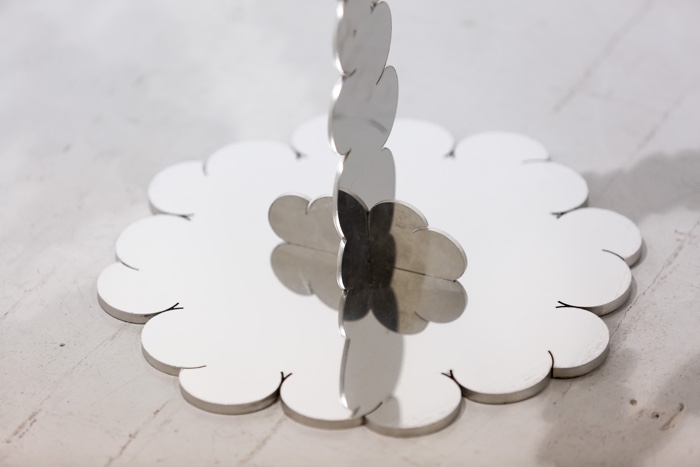
Julijonas Urbonas, A Planet of People, 2017 – 2019. Installation view (detail), Vartai Gallery, Vilnius
You’re interested in ‘gravitational aesthetics’ and have applied it to topics related to death (the Euthanasia Coaster being the most famous example). Have you ever thought of applying it to purely entertaining contexts, going back to the Soviet amusement park of your childhood?
To be honest, I do not know what ‘pure entertainment’ is. If it is a total distraction and infinite euphoria, I imagine it would be rather a unique kind of extreme horror without fear, cruelty and gruesomeness. Such an ‘entertainment’ would also be the love of oppression, the adornment of the technologies that undo one’s capacities to think. Neil Postman has depicted it nicely t in his book Amusing Ourselves to Death. If this is the kind of amusement you mean, then some of my projects are already epitomising that kind of thinking. Consider Cumspin, an orgasm-enhancing amusement ride.
Actually, I keep getting all kinds of enquiries about the feasibility and financial aspects of such projects of mine. I haven’t done any feasibility studies and am not interested in doing so until somebody would do it by themselves. It would take me an enormous amount of time which I would rather spend on art making and daydreaming, and there is nothing more precious than that. It would also be super-expensive. None of the enquirers have gone that far yet.
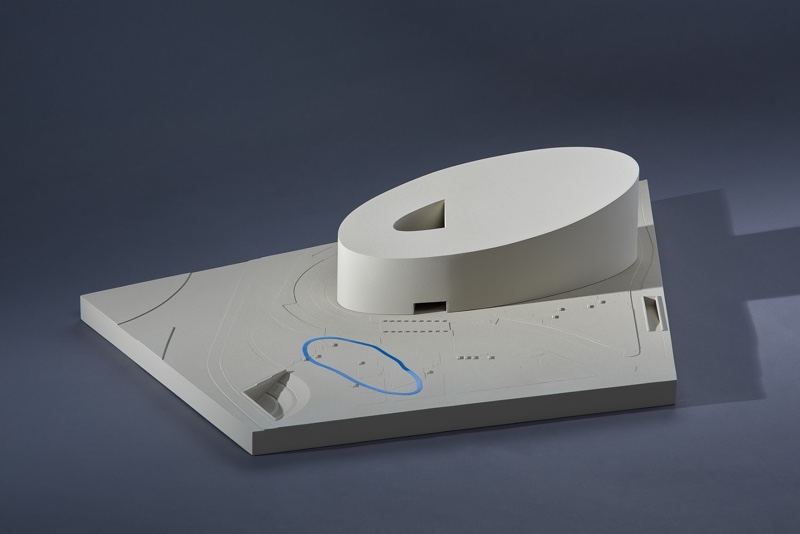
A scale model of the “Blue Loop”. Photo: Darius Petrulaitis
However, I have recently started developing a parallel line of work that is more a down-to-earth kind of amusement. All of them are mostly public art projects. Three of them are already funded and are at the late engineering stages. One of them is a playground for children, and another one is more like a hybrid of a sculpture and an amusement ride. At the moment I can reveal only one of them: it is called “Blue Loop”, a project commissioned by the Vilnius Municipality. It is basically a loop-shaped path – part runner track, part urban-scale graphic art. Casually drawn on the bird-view photo of a public square, the line circles and binds the loose elements of the space. The path crosses and penetrates all the landscape elements: the paved pedestrian zones, the green sections, the parking lot, the playground, etc. This scribble is also a sort of choreographic device with its specially shaped curves and turns of varying degree. The workers at the business centre next to the square intend to use it as a substitute for a coffee break spot. However, the place has poor air quality, and we are currently engineering a special air quality station that would control the lighting of the path. If the path is lit green, you will be able to safely take a jog.
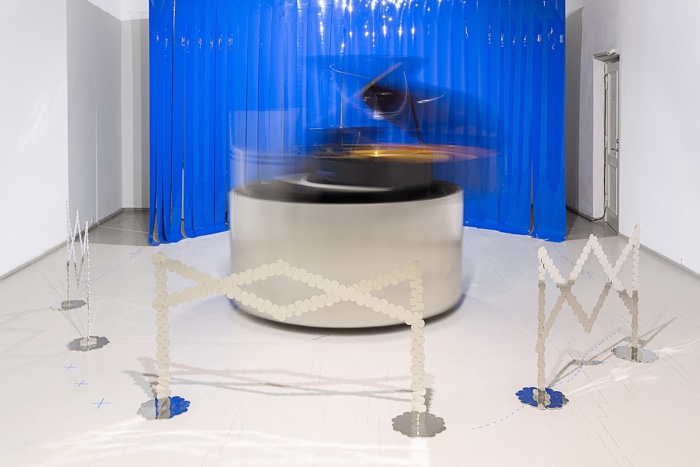
Julijonas Urbonas, Hypergravitational Piano,, 2017 – 2019. Installation view, Vartai Gallery, Vilnius
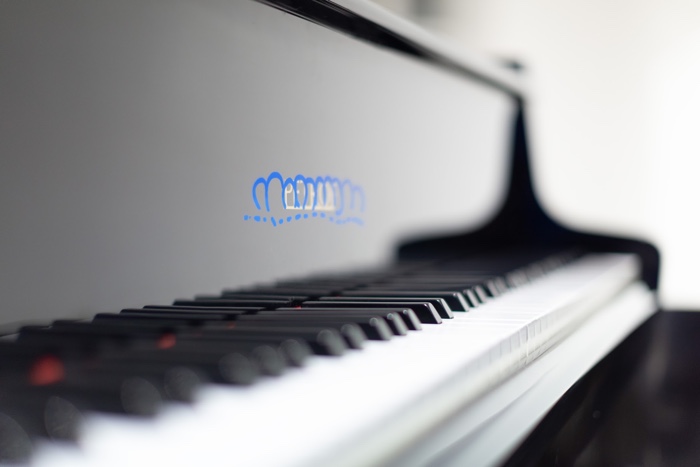
Julijonas Urbonas, Hypergravitational Piano, 2017 – 2019. Installation view, Vartai Gallery, Vilnius
The gallery installation is visually very appealing, even though I’m not sure I fully understand what I’m looking at. Could you describe what we see in the photos above? What is Hypergravitational Piano and what is its purpose?
Hypergravitantional Piano is a hybrid of a grand piano and a human centrifuge. The composer Gailė Griciūte composed a special piece that she also occasionally played during the exhibition. It was sort of a soundtrack for A Planet of People and a staged thought experiment for the extra-terrestrial sound piece.
A Planet of People might be considered as a thought experiment aiming to see what happens to choreography, architecture, music, and arts in general, once they cross the Kármán line. The majority of these kind of experiments have already appeared in my texts and lectures, slowly advancing towards the establishment of what I call exo-disciplinary arts. But it is just recently that they started transition from the mental and literary domains into artistic installations. One of them – Hypergravitantional Piano – is exactly that. In fact, I engineered it along with other six revolving platforms specifically for the opera Honey, Moon!, where I was also both a director and a stage designer. Together with the composer Gailė Griciūte and others we were speculating upon the genre of opera under the conditions of outer space – a sort of ‘true’ space opera.
Julijonas Urbonas, Honey, Moon! – Opera, Art Installation, 2018
When I talk about all of these space conditions, by ‘cosmic’ I usually mean altered states of gravity: weightlessness, artificial gravity, hypergravity, etc. Hypergravitantional Piano uses the centrifugal force of spinning to produce artificial gravity, the force that pushes the piano player to the backrest. With each rehearsal and performance we increase the force and observe the effects upon the player, the instrument, the sound and the music in general. The composition changes in time while we experiment with spinning choreography. Such an artificial gravity produces unique gravitational fields that vary at different points of both the player and the piano. The force increases away from the spin axis. Thus, the fingers feel a weaker pull then the head or the back, and the movement of the playing hands are affected by the complex Coriolis forces. So are the piano strings. A constantly changing orientation of the instrument affects the way the sound propagates. Of course, we’re not working with high forces, we are spinning the thing at moderate speeds, producing maximum ~1.5 G (a force one and a half times higher than Earth’s gravity), but the composer has already observed that this has a unique physical and psychological effect on her creative mind and thus makes way for the hypergravitational sound and listenership.
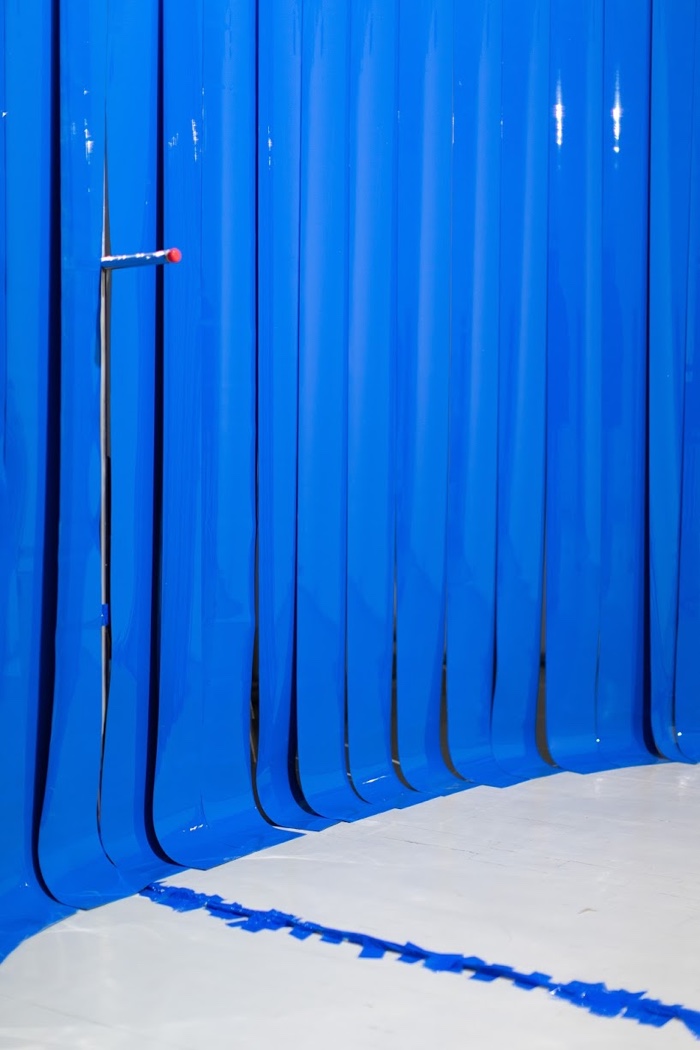
Julijonas Urbonas, A Planet of People, 2017 – 2019. Installation view (detail), Vartai Gallery, Vilnius
Does the royal blue colouring of the curtains have any significance? I think you have used that colour in your previous works (in Milan?)
You’re right, the colour – namely RAL5017 – was used for my project Airtime, a floor that lifts up and drops down beneath the visitor’s feet. I covered the surface of the moving floor with a special rubber material due to its shock absorbing features. There are just a few colours in the industrial rubber pallet. So I picked the blue one as it looked photogenic, it also seemed to hint towards the ‘airy’ context, but also because, historically, it is the last color that humans learned to perceive.
Thanks Julijonas!
Previously: The Euthanasia Coaster.
